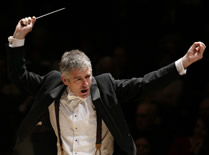The North Carolina Symphony, led by its music director Grant Llewellyn, offered a large-scale romantic program in Kenan Auditorium which captured a sweeping range of sounds and moods. The first work was Liszt’s fiery Hungarian Rhapsody No. 2, transcribed for orchestra. There are gains and losses from recasting such an idiomatic piano piece in this way. The almost unbridled virtuosity of the original is largely lost. On the other hand, an enormous range of color is added. In this performance, the balance swung in favor of the color capabilities of the orchestra. There was an overall feeling of spontaneity and flair. The start was passionate and was followed by a bracing clarinet solo. As the piece progressed, the shifts of tempo and rhythm – which could make the total seem disparate – were convincingly connected. Combined with the dazzling orchestral sounds, the piece came over as almost more wildly rhapsodic than it is on the piano.
The next work was the “Rákóczy March” from The Damnation of Faust by Berlioz. In comparison with the Liszt, it seemed tame. Though set in Berlioz’ characteristically colorful orchestration, the regularity of material and phrasing made it nowhere nearly as vibrant. The ending was strongly played by the orchestra, however.
The next piece, the Prelude to Wagner’s Lohengrin, could not have been more contrasting. This music evokes celestial realms, far from the hubbub of our world. The orchestra gave it finely focused phrasing, sustained over the length of the piece. The climax was rich and sonorous rather than stentorian and the whole was flawlessly shaped and proportioned. The ending captured all the ethereal quality one could hope for. The only reservation came earlier in the piece, when the dotted rhythms seemed consistently rather sharp for such a gentle, lyrical context.
The close of the first half brought things back to Liszt, with his epic symphonic poem Mazeppa. This piece epitomizes both the brilliance of Liszt and his penchant for what the concert’s program notes call “effusive romantic excess.” Still, it is an effective work and the orchestra did much fine playing. The episode on horseback that opens the piece could have been wilder; that was achieved, however, in the major mode episode at the end of the section. In Mazeppa’s theme, the trombones, while strong, seemed somewhat restrained. This may have been due to their pulling back on their powerful notes, rather than sustaining them slightly longer in double forte. The lyrical transformation of the theme featured a finely-shaped peak. The exhausted interlude between the main sections was effectively drooping in character. The buildup to the last section started rather loudly in the trumpets, which ruled out a powerful crescendo. But the ending was bright and effective.
The second half was devoted to Rachmaninoff’s ever-popular, virtuosic and achingly lyrical Piano Concerto No. 2. The soloist was the British pianist Stephen Hough. The central characteristics of the performance were: brilliance in the technique, with highly-articulated finger work; an impressively powerful sound in the forte sections; and generous rubato mixing with an almost brisk, notey approach to the expansive melodic phrases. The exception to this latter was the second theme of the third movement, which was noticeably gentler. If the pianist’s performance did not transport the listener with its lyrical beauties, it nonetheless offered much to appreciate. The return of the theme in the second movement had a touch of magic. And the ending of the concerto was impressive, with its powerful reprise of the second theme followed by a brilliant and exciting coda. The orchestra contributed mellow-toned and finely-phrased support.
In an unusual gesture, Mr. Hough played a solo encore after the concerto: the popular E-flat Nocturne by Chopin. Here he captured the long-lined phrasing and cantabile sound that would have also suited the Rachmaninoff. The piece was a perfect balance to the grandeur of the preceding program.
This concert will be repeated in Raleigh on the February 24 and 25.












